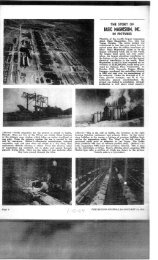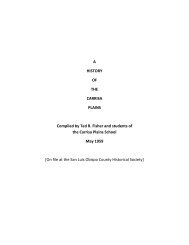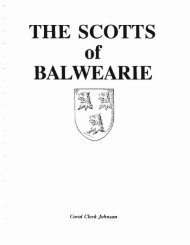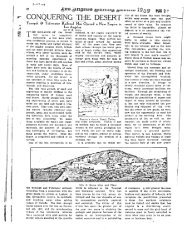1940 - part 2 - Vredenburgh.org
1940 - part 2 - Vredenburgh.org
1940 - part 2 - Vredenburgh.org
You also want an ePaper? Increase the reach of your titles
YUMPU automatically turns print PDFs into web optimized ePapers that Google loves.
THOMAS S. W AHREN· discusses<br />
White Magic With Black Light<br />
IMAGINE operating a gold mine for 60<br />
years and then to find that there<br />
was enough Bcheelite in the tailings to have<br />
paid the operating expenses of the mine!<br />
lm~gine, too, the disappointment of the<br />
lone prospector in Arizona who had dug<br />
a tunnel for 60 feet along a vein (always<br />
hoping that the gold values would increase<br />
and that his prospect some day would become<br />
a mine) when he learned that he had<br />
thrown a fortune in scheelite on the dump.<br />
Or again, imagine the prospector on a<br />
California desert who dug six prospect holes<br />
in the side of a mountain, three of which<br />
uncovered an extensive deposit of sheelite,<br />
but abandoned the holes as there was not<br />
enough lead in the property to warrant<br />
further assessment work. Yet the next<br />
man was in line for a fortune, because he<br />
used a fluorescent lamp and discovered the<br />
scheelite which had been discarded.<br />
There are innumerable such cases which<br />
might be used to illu'strate the value of an<br />
ultra-violet black light for mining purposes.<br />
Scheelite is used here as the example<br />
because scheelite is the most common<br />
fluorescent commercial mineral, but<br />
there are hundreds of other uses for the<br />
Mineralight black lamp.<br />
Night prospecting is an unusual but a<br />
very profitable development of recent<br />
years. The old-time prospector considered<br />
his work done when the sun had set, but<br />
many modern prospectors are just beginning<br />
their work when the sun goes down.<br />
The instrument which has changed this<br />
procedure is the ultra-violet black light,<br />
It might be best at this point to explain<br />
why c:ertain lamps are of value and others<br />
are practically useless. In the first place,<br />
ordinary light will not create fluorescence<br />
Fluorescence is the result of a stimulation<br />
to the atoms of the mineral. There are<br />
two general groups of ultra-violet wave<br />
lengths-the long wave lengths and the<br />
short wave lengths. The long wave length<br />
ultra-violet will stimulate fluorescence in a<br />
few materials, such as dakeite, semi-opal,<br />
wernerite, benitoite, and fluorite. On the<br />
other hand, the short Ultra-violet waVt:<br />
lengths will cause fluorescence of over 300<br />
minerals, including all the minerals listed<br />
above that fluoresce by means of the<br />
long wave lengths. Among these many<br />
minerals are barites, calcites, colemanite,<br />
hackmanite, halite, hydrozincit(', kunsite,<br />
opal, pectolite, scheelite, wollastonite, and<br />
,smithsonite., .<br />
While there are a number of ultra-violet<br />
, , light' sou"rc.es, ,there is ' only one source of<br />
the short wave lengths and that is a genuine<br />
quartz light equipped ' with a special<br />
, filter which screens out the visible light<br />
and allows the transmi8Bion of only the<br />
ultra-violet. None of the other ultra-violet<br />
•....... nt. Ultrcr·Viol.t Products. Inc:..<br />
Allvol... CaUlomla.<br />
PBfI. t<br />
to.<br />
The commercial application 01<br />
ultra-violet light to mining. while<br />
only about live years old. has a<br />
number 01 noteworthy successes<br />
to its credit. It has proved to be 01<br />
<strong>part</strong>icular value in the prosPecting<br />
lor scheelite becausescheelite is<br />
the most important commercial<br />
mineral which fluoresces.<br />
light sources transmits the short wave<br />
lengths, and for this reason their use<br />
is very limited in the mineral field. The<br />
only type of light which can be used in<br />
prospecting for scheelite is the coiled<br />
quartz tube lamp.<br />
Many prospectors have attempted to<br />
make their own black light lamp by using<br />
a filter in front of an ordinary flashlight<br />
bulb. This filter screens out the visible<br />
light, but there are none of the short ultraviolet<br />
rays formed by the bulb. As a result,<br />
the lamp is useless in the detection of<br />
scheelite. These long wave ultra-violet rays<br />
do not cause the fluorescence of any minerals<br />
which have commercial value and<br />
though this light source is the cheapest it<br />
is the most expensive in the end, because<br />
For un'derI'round work a compact ••• emh1,<br />
for a MineraliI'ht i. pro.ided by • Hot·Shot<br />
hattery and a ,6·.olt trandormer .• ,upended<br />
from tb •• boulder.. Th. pletare iIIu.tratn<br />
an .... mbl,. of thi. kind hein. 'uNd in<br />
examination of • tuna.ten p~erty.<br />
a person would walk over a rich scheelitc<br />
deposit and not know it was there.<br />
Bulb lamps are used sometimes by col.<br />
lectors, but they have no value in com.<br />
mercial ores because they generate only the<br />
long wave length light. . .<br />
T<br />
HE explanation of f1uor~s ct! nce and<br />
phosphorescence is technical and involves<br />
a high degree of mathematics,. but if<br />
we eliminate all technical details for the<br />
present and attempt to explain the proh.<br />
lem in its main essentials we can secure 8<br />
fairly good idea of how these phenomena<br />
are caused.<br />
It is wen known that all minerals are<br />
made up of atoms, and each atom is com ~<br />
posed of smaller <strong>part</strong>icles such a protons,<br />
electrons, neutrons, positrons, etc. Thp.<br />
electrons are supposed to circulate arouno<br />
the nucleus and the simplified theory of<br />
fluorescence is that the ultra-violet energy<br />
which strikes the atom is absorbed in thE'!<br />
electron, causing it to change its orbit<br />
around the nucleus. Once it has changed<br />
its orbit it proceeds to lose its energy and<br />
returns to its original orbit. This releast'.II<br />
energy which comes to us in the form of<br />
light. The wave length of this light determines<br />
.Pte color of the fluorescence.<br />
While the entire p~ocess of collecting<br />
energy, moving into new orbits, giving up<br />
the energy, and returning to, the origipa.1<br />
path takes place in a very small fraction of<br />
a second, we only see the light while the<br />
substance is being exposed to the stimulus<br />
of the ultra-violet rays, and this is the phenomenon<br />
we call Hfluorescence." .<br />
Some minerals are much slower in their<br />
reaction, and the electrons remain in their<br />
unnatural orbits for an appreciable length<br />
of time. In such. cases we continue to see<br />
the light after the ultra-violet light source<br />
has been removed. This is the explanation<br />
for u,{)hosphorescence," and is illustrated<br />
by the minerals , which glow after the light<br />
is taken away, the glow gradually diminishing.<br />
This simple explanation of "fluorescence"<br />
and "phosphorescence" is not technically<br />
correct, but it is near enough'to give<br />
anyone an idea as to how the fluorescence<br />
does occur.<br />
E HAVE made considerable mention of<br />
Wthe prospecting for scheelite because<br />
this is the most important commercial min·<br />
eral which fluoresC'1Oi8. In most cases the<br />
scheelite fluoresces ... bright blue and it is<br />
possible to determine instantaneou'sly tht<br />
probable extent and quality of the sche.elite<br />
ore.<br />
The Mineralight· lamp, which· preferaply<br />
is ' used at night, causes each 'scb:eelite<br />
crystal to fluoresce brilliantly and' il'l<br />
loeations where the ore is very rich a rock:<br />
wan wiH stand out as though · it wera<br />
studded with millions of stars or diamondE.<br />
, In the prospecting 'for scheelite it is, extremely<br />
difficult to Jocate the o~e beQ ....<br />
of the wide variety of roeka in "hlch It<br />
,.- .<br />
THE MINING JOURNAL lor OCTOBER 30, 1'40















